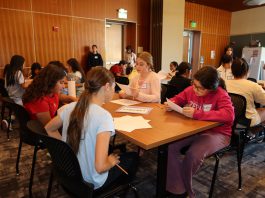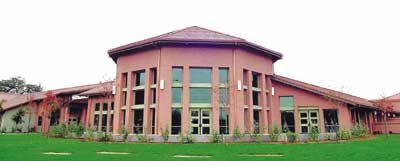Letter to the editor: District elections are an insult
I would like to join the many voters in Morgan Hill that agree with John McKay’s “Our Town” commentary (from the Sept. 15 edition of the Morgan Hill Times) regarding district elections. Not only is district voting a travesty, but it is an insult to every voter in our city!We do not need to be told how to vote or who to vote for. The fact is, our city council has enjoyed amazing representation of the diversity of Morgan Hill. When we had a choice to vote someone out of council and vote for a new candidate, we did. This district voting scheme is just that: another way for losing candidates to force themselves on the voting public!Look at what has happened at the Morgan Hill Unified School District! In the last election, we had one district with only one candidate, because other very qualified candidates lived outside that district.District elections narrow our choices and may very well force the voters to send an unqualified candidate to office.On the MHUSD board, we have a split board that rarely, if ever agrees with one another, and we have a board member that we know very little about that ran unopposed from her district. We, in Morgan Hill, deserve better than this on our school board and at city council!Please don’t insult our intelligence with district elections and term limits. Let the voters decide who is best qualified and aligns with our values in order to address the complicated issues we face.This insult is being forced upon us because of a few losers that ran and did not win want an advantage to their losing cause.A threat of a lawsuit is a challenge, not a reason to roll over and give these losers an advantage. Shame on us!Ever Onward,Swanee EdwardsMorgan Hill
Letter to the editor: The other side of the story
I’m Lance Wolfsmith, Dave Wolfsmith’s son. Despite the local smear campaign against my father, my family and I couldn’t be prouder to call Morgan Hill home. I’m eternally grateful for amazing support my family has received from many in the community.I’ve been a Wolfpak member for 20 years, and I know every victim personally. What you’ve seen in the media is the perception of less than 2 percent of the athletes my father coached. I refuse to let this be his legacy.My father’s passion and conviction makes him polarizing. You don’t hire a coach if you're satisfied with your current situation, and when you hire my dad, your success becomes his priority. Through expert knowledge, passion and accountability, his clients achieved amazing results.The most profound memory with my dad was before my freshman year of high school when he set aside time for goal setting. Measurable goals were inappropriate because my ability was unknown, so my father simply asked me how good I wanted to be. Naturally, I wanted to be the best, so he made known the sacrifice and hard work that would be required. He assured me that together, we would accomplish my goals, and until those goals changed he would hold me accountable. Because of my father’s commitment to me, I was blessed with a lot of success during my high school and collegiate athletic career.What’s amazing is that commitment wasn’t exclusive to me. Over his 30-year career, nearly 1,000 clients received his commitment. He trained the full spectrum of athletes—from children and soccer moms, to collegiate athletes and elite military operators. Not once did my father advertise; every client was the result of a praising recommendation.I’ll never know the “why” behind these accusations. I have years of great memories with each victim and knew these people better than many members of my own family. Many trained years ago, a few came and went multiple times, but all continued to train at their own will after their assaults. The toughest for me to wrap my head around is that a group of victims trained with my father up until his arrest.My intent isn't to attack any victims, but to shed light on the other side to this story. I believe most people in our community have good intentions, but they've only been exposed to an extremely biased fraction of the story.Martin Luther King said, “Nothing in all the world is more dangerous than sincere ignorance and conscientious stupidity.”Sexual assault accusations do not always require physical evidence for a conviction, which leaves no tolerance for ignorance. Before his plea, my father’s accusations were broadcasted to millions, his business was taken, and he spent nearly a year in jail. As a community, that should concern everyone.I was raised a strong supporter of the law, but my family learned the hard way that innocence until proven guilty is nothing but a fantasy reserved for those wealthy enough to fight.I urge you to critically exam what you read in the news and see on TV. Too often, you're only exposed to a fraction of the story and as good as your intentions may be, they can be misguided.The bond I have with my father and family has only grown stronger. Together we will pass this test and remain unshaken, because we know the complete story and will continue to stand by my father.Lance Wolfsmith, 1Lt, USAFEditor’s note: Former Morgan Hill personal trainer David Wolfsmith pleaded guilty June 23 to 12 counts of sexual battery by fraudulent purpose, and one count of lewd and lascivious acts against a child younger than 14 and a misdemeanor child molestation charge. On Aug. 23, he was sentenced to seven years in prison.
Letter to the editor: Gavilan bond illegal?
The Gavilan College Board of Trustees is considering putting another bond before the voters in 2018. At the Aug. 8 board meeting the trustees approved an agreement with True North Research Inc. to provide a general obligation bond measure pre-election survey.I have always been a supporter of educational issues at all levels. However, I have also always believed very strongly that all elected officials must abide by the law to earn the trust of the voters who elected them.With the previous bond (Measure E), the Gavilan Board of Trustees violated Prop 39 by illegally spending bond funds to set up the South Bay Public Safety Consortium (the Academy) at the satellite site in Coyote Valley. Because Administration of Justice was not included in the bond, spending bond funds on Police Training Facilities was a clear violation of Prop 39.Prop 39 bond measures must list the specific projects to be funded. The South Bay Public Safety Consortium was never on the list of specific projects presented and approved by the voters. The evidence that Prop 39 was violated, I believe, is overwhelming.Because of the controversy over the misuse of Measure E bond funds, convincing the voters to support another bond will be a very difficult task.Aurelio ZunigaHollister
Letter to the editor: Council should participate in district drawing exercise
Dear Mayor and Council members,
Letters to the editor: District elections, Community Based Instruction
Many questions about district electionsDear Morgan Hill City Council,At the City Council meeting on June 7, you decided on your own to change to District elections for Council members.You had a very clear example that our residents will step forward on short notice and at a challenging time of the year to prepare applications and attend interview sessions. Over 20 well-qualified residents expressed their interest in filling the vacancy left by Gordon Siebert at the end of last year.Yet you claimed that the short time period and challenging time of the year prevented you from forming a Citizen Advisory Committee. So your direction to staff is to support workshops (which currently have no definition). Historically, most public comment at your meetings and workshops are one-way input to you, not actual discussion and debate.If a district has no candidates, does the council do an appointment? If so, would that be the same process that was used to replace Mr. Siebert?When you have formed districts, under what conditions could we still be sued for bias?How will district boundaries evolve over time? Does this become an issue with the city’s Residential Development Control System?What is the definition of equitable representation?Who represents those who are financially insecure?Who represents those who live in apartments or mobile home parks?Given the very different levels of resident involvement in our last election campaign and the following appointment process, we should have had a city-wide discussion on how to get more residents involved in selecting who decides how our city operates. Instead, we get a mandatefrom council to go to district elections for council members.More than once, Council member Rich Constantine stated that the city had done nothing wrong. Yet you chose to be stampeded by the lawyer trolls. And it was a choice for you to make, even though you claimed that the outcome was forced on you by the cost/benefit analysis.Thank you for your consideration,Doug MuirheadMorgan Hill Thanks for promoting WorkAbilityThe Morgan Hill Unified School District WorkAbility/TPP office would like to take a moment and thank those business who have signed on to open their doors to our students to assist them in learning and practicing new job skills. Please patronise these merchants and thank them for giving back to our community.If your business is interested in investing in the youth of Morgan Hill in this way, please give us a call at (408) 201-6300 ex. 42217. The student’s salary and workers compensation insurance are paid by the district, so it is a win-win!The following businesses have signed on so far: Ace Hardware/Johnson Nursery, Advance Haircuts, Bargain Hunters Outlet, Community Garage and Towing/Ponzinis, Goodwill of Silicon Valley, Granada Theatre / Willow Heights Mansion, GVA Cafe, Made in Japan/Europe/USA, Massive Sounds with DJ Guy, Maurizio's, Morgan Hill Foods, Prova California Table, Rosy’s at the Beach, St. Vincent de Paul’s Thrift Shop, TJ Maxx, Top Knot Salon and YMCA/CRC.WorkAbility I and the Transition Partnership Program of Morgan Hill Unified is a program for high school students in special education. For five weeks beginning June 19, a group of 14- to 21-year-olds will be hitting Morgan Hill for some Community Based Instruction (CBI).The purpose of CBI is to promote each student’s community knowledge through instruction, participation and real world experience.CBI combines functional academics, social skills and job skills. Students practice essential life skills like how to purchase items, order lunch and make sure they have received the correct change. They learn how to dress for work, fill out time cards complete with proper signature, and how to be independent and confident in their community.We hope to meet you while we are out and about this summer!Catherine CanoMHUSD Job Developer
Letter to the editor: Rally The Valley promotes unity in Morgan Hill, beyond
Rally The Valley launched its debut event with live inspirational music performed by Benji Cortez and his impressive band, setting the atmosphere for a joyous and powerful event.The azure skies and mild weather were ideal for the convocation of leaders from local government, military and spiritual sectors at the Morgan Hill Community and Cultural Center’s Amphitheater June 10.Acts Revival Center, located at 17555 Peak Ave., hosted the event with the purpose of bringing unity to the community. For two and a half months, Debra Osikominu, Diahann Soleno, Victoria Salcido and Pastor Michael-John of Acts Revival Center, along with a team of dedicated volunteers, worked tirelessly on Rally The Valley.Michael-John opened the event with a powerful prayer, then introduced Morgan Hill City Council members Rene Spring and Caitlin Jachimowicz who both offered their vision and passion for the city. Dr. Ed Silvoso of Harvest Evangelism decreed a dynamic, inclusive prayer over government officials, police, firefighters, first responders, entrepreneurs and the inhabitants of Silicon Valley.Army Sgt. First Class William Carter, who is stationed in Gilroy, officially represented the military and veterans. Pastor Adam Bernal from Jubilee Christian Center prayerfully shared his heartfelt appreciation for Morgan Hill and his excitement of being a new resident of the city.Father Randy Valenton of St. Catherine Church ministered a stirring message on God’s love. David Thompson with Harvest Evangelism prayed for the families in the South Valley. Rosie Guerro of Cathedral of Faith and Carmen Martinez of Acts Revival Center both poured out their hearts, expressing Christ’s love for the poor, disenfranchised and the broken hearted.Several leaders approached Michael-John after the event, sharing how impressed they were with the spirit of unity present. They offered to be a part of future Rally The Valley events.Michael-John echoed the same sentiment: “There was freshness in the atmosphere as God’s love permeated the grounds, and as if on cue, the fountains in the courtyard sprang to life, propelling jets of water high into the air . . . signifying new things to come.”The vision for Rally The Valley spawned from God because of His love for the community. The church meets 10 a.m. Sunday mornings in the Morgan Hill City Council Chambers, 17555 Peak Ave. The newly remodeled chamber is an ideal locale for the innovative church and its pastor, who isn't confined to stuffy religious methods. His pastoral ability goes beyond the realm of the traditional function of a minister because of his love for people, combined with his entrepreneurial and entertainment background.Some of the expanded benefits of the ministry include life coaching, business consulting, mentorship, counseling for married couples and deep teaching of God’s word, which draws the congregation closer to their creator. Acts Revival Center ministers to a wide range of people with various backgrounds and careers. It’s a creative church, designed for Silicon Valley. Attendees include doctors, high-tech security personnel, authors, engineers, game designers, artists, secretaries, retail managers, police, students, entrepreneurs, realtors and the homeless. The pastor helps guide each person to achieve their prophetic destiny with wisdom from the Word of God, touching their relationships and careers. Acts Revival Center has four locations: San Jose, Morgan Hill, Gilroy and Los Angeles.For more information, please visit actsrevivalcenter.com.Angela YoungMorgan Hill
Letter to the editor: Council violates development extension ordinance
On May 17, the City Council voted 3-2 (Caitlin Jachimowicz, Rene Spring against) to approve a time extension request for a construction project proposed for the corner of East Dunne and Murphy avenues. At face value, that may not seem like a big deal. But, since last December two significant actions occurred—one questionable, and one that shouldn't be legal.Last December, the developer requested an extension for this project. Even though it only fulfilled one of eight requirements to qualify for an extension, the Council (4-1, Spring against) determined there was enough potential impact to the neighboring residents and church that granting an unqualified extension was in the best interest of the city. At the urging of Councilmember Larry Carr, a stipulation was added to the amended agreement, Section #11 of Ordinance #2228, that "No further extension will be provided."On May 17, Mayor Steve Tate and Councilmembers Carr and Rich Constantine broke their word and approved another six-month extension for the project, violating the restriction they voted into the ordinance. I have a problem with that. I think the residents of Morgan Hill should have a problem with that, too. Not because a bunch of houses will be built where a bunch of houses will eventually be built, but because three members of the city council violated an ordinance to resolve their problem.The council says they have the authority to amend development agreements. That's true, but what makes this agreement different from other agreements is the council added a specific restriction in Section #11 prohibiting an extension. Ordinance language is legally binding, and the council had sufficient time to amend Section #11.The developer's request was in the city's hands at the end of March. There were two council meetings and one planning commission meeting prior to the May 17 vote, with included staff reports noting the extension request. I sent at least three emails questioning this extension. Tate, Carr and Constantine chose to put all that and Section #11 aside, and simply changed the agreement to approve the extension. Their only justification was a very convenient "what's best for the city" excuse.It's hard for me to trust members of our city council who feel comfortable violating ordinances, except in an emergency, by simply saying they're doing "what's best for the city." What’s best for the city is having leaders who stand behind the integrity they say they have, who demonstrate that the rules apply to them and developers as much as the rules apply to everyone else in Morgan Hill. I've heard no legal explanation allowing Mayor Tate, Mr. Carr or Mr. Constantine to circumvent the restriction in Section #11. In their "what's best for the city" excuse, I only heard them attempting to absolve themselves of guilty feelings for going back on their word.The council can still fix this. I hope they do. I think it's more important to build trust through integrity and credibility than to build a few houses.Chris MonackMorgan Hill
Letter to the editor: Unlicensed staff to perform invasive procedures?
Unlicensed staff to perform invasive procedures?I am a health clerk at Morgan Hill Unified School District and it is very important to know the facts.MHUSD is trying to change our Health Clerk Job descriptions to include ALL RN and LVN invasive procedures. This includes catheterization, feeding tubes, administration of insulin and any other invasive procedure that an RN or LVN is educated, trained and licensed to perform. We the health clerks already oversee (watch over) our diabetic students every day. This is not just about giving insulin to our diabetic students! We are not licensed nor do we have the medical training/education needed to perform any of these invasive duties.The problem is not with the Health Clerks, it is with MHUSD. This issue is clearly fueled by an allocation of funds. They have allowed the already established jobs of the RN and LVNs within MHUSD to become grossly understaffed, which prevents the students from receiving the care and procedures that they require on a daily basis. I am sure that the parents of students who require specialized procedures would not want someone with no medical training, who is not licensed or qualified, to perform any of these invasive duties on their child.• We are not Registered Nurses or LVNs; we are not licensed at all. We have no medical training or education except for first aid and CPR. • We are only at our school sites for three or four hours a day. This is what MHUSD gives us to do our jobs.• In that allotted time, we can see up to 30 students for multiple reasons which also requires documentation and notification to parents.• We have multiple students in our health clerk offices at once. We are required to multi-task most of the day, every day.• We have many clerical duties that we are required to complete to keep MHUSD compliant with county and state requirements.We the health clerks are unable to obtain any kind of malpractice or personal liability insurance to protect us and our families from a civil lawsuit. While MHUSD has some coverage, even the RNs and LVNs hold their own liability insurance. We the health clerks are not able to obtain any insurance to cover us. It is unethical for MHUSD to ask the health clerks to put us and our families at risk of a civil lawsuit.We the health clerks love our jobs and do the very best for the many students we see each day with our limited first aid and CPR training. I myself have been doing this job at my same site for 16 years and couldn’t think of anything else I would rather do. Our students’ health and safety is our number one priority. We truly hope that the public understands that changing our health clerk job description to include invasive RN and LVN duties is so much more than diabetes. We urge the public to require MHUSD to re-staff the RN and LVN positions so that our students attending schools in MHUSD are safe and receiving the best possible care that they need and deserve.Heidi CurielMorgan Hill
Letters to the editor: High speed rail, Morgan Hill renaissance
Think big for Morgan HillMorgan Hill is going through a renaissance of sorts.Downtown is finally blossoming into the vibrant scene we always wanted and knew was possible. Construction is booming, and not just on the Granada Hotel, Sunsweet project or any of the other economic developments going on, with three new parks scheduled to be built and finished this year in downtown.Downtown Morgan Hill is actualizing into our dreams for a prosperous, inviting and sustainable city center, and I couldn’t be happier.But the renaissance I’m referring to is not the one of our downtown. I’m talking about the rebirth of innovation in Morgan Hill; the revival of our Silicon Valley spirit.If you’ve been following news on self-driving cars and the technologies used in them, you may have heard of Morgan Hill-based Velodyne LiDAR, a high tech sensor producer that has worked with Google, Baidu and Ford on autonomous vehicles.If you’re into cutting edge recreation, you might have heard how Morgan Hill’s own industry-leading Specialized recently won 2017 Bike of the Year for its Roubaix Comp model.Morgan Hill companies are leaders in their respective fields and now some South Valley entrepreneurs are trying to help make Morgan Hill a true center for innovation with their upcoming Innovation Goes Outside Disrupt Forum, a local networking event and pitchfest. Never before have local leaders taken such proactive measures to help grow an innovative incubation community in Morgan Hill.Now is the opportunity to grow Morgan Hill as an integrated center of innovation in Silicon Valley. After all, this seems the logical step for a city with pioneering startups and an ideal location within Silicon Valley.Mayor Tate and Councilman Spring both came from tech and most of the other city councilmembers have experience working with tech or with Silicon Valley as a region.We are a population poised with the expertise to transform the future of Morgan Hill’s economy and culture. Our residents are more educated than both the California and national averages. Our schools continue to succeed above state and national graduation rates. In fact, our schools are now even expanding comprehensive opportunities for our students to explore (Paradise Valley Elementary transformed into Paradise Valley Engineering Academy last year).Our infrastructure is constantly improving and the investment that’s been put into our downtown will radically improve our community and its attractiveness as a great place to live and work. We have a chance to come together and actively work to make Morgan Hill all it can be.So let’s connect our local Silicon Valley veterans with new startups. Lets help incubate local businesses and support a culture of innovation. To do this we have to think big; we have to #ThinkMorganHill.Christian AntunesMorgan HillRail is a FailWe can glimpse what's in store for South County with the arrival of the Bullet Train by looking at those Monterey Salinas Transit ("MST") luxury yachts that sail past your old office every day going to the local Transit Hub. Why don't you tell your readers the truth about the losses taxpayers sustain with those ultra extravagant examples of government transport gone amok? Of course, you'll have to look at legal accounting for their losses, and not the losses reported by the transit agency.Why? The legislature has exempted the transit agencies from using legal accounting (aka Generally Accepted Accounting Principles = GAAP), which federal and state tax regs require that everyone use. This has the effect of hiding the true extent of their losses. They all do it: VTA, TAMC, SCCRTC, etc. So, when you read Mr. Roadshow's articles about the "fare box recovery rate" on transit, bus or rail, you are seeing what the transit agencies report—far from truth in transportation.Since fares are not remunerative, meaning that they don't cover their costs (all of their costs), they can never run in the black; only in the red. So, to keep going, they need heavy infusions of OPM—motorists, truckers and motorcyclists. If they wanted to be transparent and accountable, then they would use legal accounting, and tell us just how badly they are screwing us. But they use Enron-style, Bernie Madoff-style, "off book" accounting.Take a look at Amtrak's reported losses; Caltrain's losses. Then adjust for GAAP accounting, if you want to let your readers know the truth about the waste, fraud and abuse at the joint power authorities ("JPAs"), MST, VTA, TAMC, SCCRTC, etc. Then, if you want your readers to get informed about what the Bullet Train is going to do to us, extrapolate the MST's losses by factors of 100s, 1000s, etc.Please give us truth in transportation; it would be a refreshing change.Joe ThompsonGilroy

















